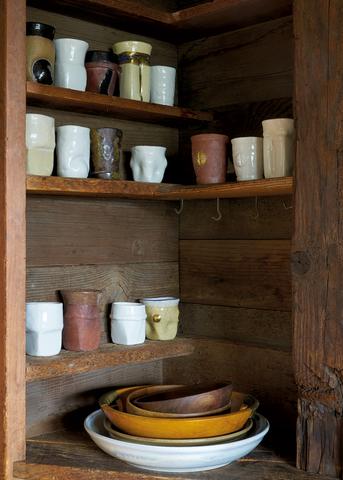
Leslie Williamson, 'Blunk Cups in J.B. Blunk's Home'
“Pick a cup,” my father would say to guests when they came by our house for tea. Each guest would study and choose their favorite from our dedicated “cup nook”: seven shelves built in a corner of the kitchen lined with handmade ceramic vessels.
My father, artist J.B. Blunk, made all the ceramics in our home. The plates, bowls and cups were typically made from clay dug from local beaches and hillsides — the color palette consisted largely of dark browns, blacks, blues, whites, and golds.
My father learned how to make ceramics in Japan in 1950. While stationed in Korea during the Korean War, he visited Japan regularly, searching for the work of ceramicist Shoji Hamada, whose ceramics he had seen in an exhibition in Los Angeles. After a chance encounter with sculptor Isamu Noguchi in a mingei (craft) shop he was introduced to famed potters Kitaoji Rosanjin and Kaneshige Toyo, with whom he later apprenticed. Working with one’s hands with a natural material and engaging the mark-making of simple tools, combined with a close connection to the natural environment — these were qualities of the potter’s routine that deeply influenced my father’s approach to making ceramics and, later, to his lifestyle more broadly.
After moving to Inverness, California, in 1958, he met, again through Noguchi, the Surrealist painter Gordon Onslow Ford. Onslow Ford encouraged my father’s creative development and invited the young artist to build a home and studio for himself on land he had earlier purchased. Assembled from salvaged materials, my father crafted everything in our home, from the doors to the dining table, and all the ceramics used daily for eating and drinking.
In the 1960s, my father began working with wood, first making stools and small tables and eventually earning commissions for large-scale pieces, public sculptures and environments. Throughout his career, he moved seamlessly between diverse disciplines and media: ceramics, jewelry, painting, furniture and sculpture. For an exhibition of his work in 1981, Noguchi aptly described my father’s creative process: “I like to think that the courage and independence J.B. has shown is typically Californian, or at least Western, with a continent between to be free from the categories that are called art. Here the links seem to me more to the open sky and spaces, and the far reaches of time from where comes the burled stumps of those great trees.”
When Fanny Singer and I founded Permanent Collection, we decided to make a set of four cups using my father’s ceramics. Working closely with the Oakland-based studio Atelier Dion, we made molds of the unique pieces and cast them using white porcelain. The new set of so-called “Blunk Cups” are, of course, a departure from the original Blunk works — my father never used porcelain and always combined contrasting colors. The muted finish of the new cups emphasizes the form and texture of the originals — you can feel the indentation of his thumbprints on the surface of the largest cup — without purporting to reproduce something irre-producible: the facture of hand-painted glazes, the grit and color of hand-dug clay, the idiosyncrasies of the original.
“Nothing is precious” was one of my father’s favorite adages, and I’ve reminded myself of this over the years as the commercial value of his ceramics increases. It reaffirms the importance of continuing to live with and use his handmade wares. Producing the Blunk Cups was one way to continue and amplify my father’s legacy, to make a version of his work available to a larger community. My hope is that these new ceramics end up in more people’s cup nooks, and are lived with, used, and selected by guests when they come around for a cup for tea.
